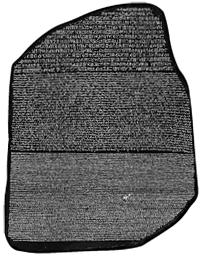
Welcome to the official website of RASHID & ROSETTA, a web art project curated by Isabelle Bernier and Salah D. Hassan, presented in collaboration with STUDIO XX and OBORO.
RASHID & ROSETTA exhibits internet-based artworks on the theme of the Rosetta Stone (see below), a famous Egyptian archeological artifact that played a central role in the decipherment of hieroglyphs. These artworks have been created specifically for the web by six artists from Egypt and Canada.
The six artists are:
• Hadil Nazmy (Alexandria)
• Skawennati Fragnito (Montreal)
• Andrew Forster (Montreal)
• Heba Farid (Cairo)
• Rehab El Sadek (Alexandria)
• Isabelle Bernier (Montreal)
RASHID & ROSETTA has been conceived and organized by a team of two
independent curators:
• Isabelle Bernier, artist, initiator and director of the project;
• Salah D. Hassan, a Canadian cultural critic whose research focuses
on narratives of Empire, anticolonial politics, and representations of
the Arab World; associate professor in the Department of English at Michigan
State University (East Lansing, Michigan).
The project was made possible by a New Media Arts grant from the Canada Council for the Arts, and has received additional funding from the Public Humanities Collaborative at Michigan State University, East Lansing, USA.
For a description of all events (launch, lectures, etc.) related to the project, click here to check the SCHEDULE.
STUDIO XX and OBORO are two artist-run centres based in Montreal, Quebec, Canada. Both are widely recognized in the field of new media and digital arts.
About STUDIO XX:
Founded in 1996, Studio XX is Montreal's
foremost feminist digital resource centre. Through a variety of creative
activities and initiatives, the Studio works with women to demystify
digital technologies, critically examining their social aspects, facilitating
women's access to technology and creating and exhibiting women's digital
art. >>>read more
Connect to STUDIO XX's website: www.studioxx.org
About OBORO:
Founded with the conviction that living transcultural artistic experiences contribute
to the betterment of humankind, OBORO is an artist centre that favours the development of
art practices locally, nationally and internationally. OBORO’s sphere of activity encompasses
visual and media arts, performing arts, new technologies and emerging practices.
>>>read more
Connect to OBORO's website: www.oboro.net
In 1799, during the occupation of Egypt by Napoleon, one of his officers found near Rashid (a small town in the Nile Delta, called “Rosette” by the French and “Rosetta” by the English) an ancient granite stela bearing one text written in three different scripts: Hieroglyphics, Demotic (a cursive script, more commonly used to write the same Egyptian language) and Greek. It is essentially thanks to this inscribed stone document that Champollion, a young French scholar, succeeded in 1822 in deciphering the Egyptian hieroglyphs. The Rosetta Stone eventually became a symbol of decipherment as well as a linguistic icon.
Because of its symbolic value, the Rosetta Stone has given its name to numerous products or projects, particularly in the fields of computer science and high tech communications where questions of language, encoding and deciphering are essential. Here are three examples: the “Rosetta Stone Library”, a Java library; the “Rosetta Disk”, a project involving the engraving of over 1,000 languages on a nickel disk, as well as a global online linguistic archive; and “Project Rosetta”, initiated by the Victoria Government (Australia) in order to connect all its data directories.
Beyond notions of language and decipherment, the Stone conveys other current associations. Indeed, its discovery was a direct consequence of a colonial war, one of many Western offensives against the Arab world – a question that remains extremely significant, notably with the invasion of Iraq in 2003. In brief, the history of this remarkable artefact not only refers to the magic of writing or the triumph of science, but also evokes war, colonialism, orientalism, egyptomania, the pillaging of the Middle East by foreign powers, etc.
With its multiple associations, the Rosetta Stone provides a very open theme, explored in many original ways by the six artists participating in Project RASHID & ROSETTA.
Back to top